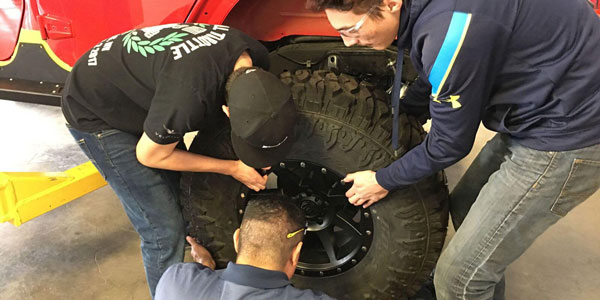Despite the industry challenges that the coronavirus pandemic has presented, the tire industry is better off than most sectors, according to data presented by GfK, a market research firm that tracks point-of-sale data from over 3,500 tire dealers across the country.
“The independent tire channel only declined by 6% in units and 5% in dollars in 2020,” said Neil Portnoy, managing director, POS tracking for tires in the U.S. “That’s pretty good considering everything we went through last year.”
Portnoy and the GfK team presented data about how the U.S. tire industry has fared during the past year in a May webinar in partnership with the Tire Industry Association (TIA). Portnoy said that despite losses, the market outperformed expectations and credits the industry’s performance to the resiliency of independent tire dealers.
“A lot of tire dealers are second- or third-generation and have lived through pretty big catastrophes historically and know how to get through tough times,” Portnoy said. “I also think you guys are nimble and can get together with your teams and develop and execute a strategy and make modifications if necessary.”
Portnoy said in 2020, the independent tire channel grew its market share compared to big-box retailers, which is a sign that the independent retail channel is strong.
“In 2016, 2017 and 2018, we saw the independent tire channel lose market share to car dealerships and big-box stores,” Portnoy said. “In 2020, our market share grew, and I think that is a trend we need to keep a really close eye on for the rest of this year and the following years to see if we can maintain that trend.”
Digging into the Data
Dave Stevens, vice president, POS tracking for tires in the U.S., explained that while 2020 unit sales were consistently lower compared to 2019, dollar sales recovered nicely for Q3 and Q4 last year.
Stevens said that the overall market was down 6.3% in 2020 compared to 2019, but there were three areas of success.
“Light truck tires with rim diameters of over 18 in. were up 12.4% over the year, while the all-weather segment was up 3.8%,” Stevens said. “In a declining market, a large section of overall sales — those Tier 4 units — were flat, which is absolutely worth noting.”
He said Tier 4 tires showed stability in unit share and unit sales, despite the slowdown at the early onset of the pandemic and fluctuations in market share for other tiers. The lack of decline in overall unit sales for Tier 4 products indicates that tire dealers made adjustments in their product lineup to satisfy the needs of price-sensitive customers.
Another data point of note: LT metric tires grew consistently throughout 2020 and currently make up 14% of the total replacement tire market.
“Overall unit sales were down in Q1 and declined in Q2, but there was still growth in this particular segment,” Stevens said about LT-metric tires. “Then in Q3 and Q4, sales took off and you see 15 to 20% growth through the back half of the year.”
He explained that flotation sizes are driving the growth. Six of the top 10 sizes in the segment are defined by flotation sizes, and it’s likely that the growth of this segment is due to the popularity of off-road vehicles.
“The requirements for social distancing led consumers to look for outdoor activities to do in small groups,” Stevens explained. “One way to do that is to go mudding in the bush. It’s a way to go out and have some fun and not be close to other people, and tire sales reflected that.”
In addition, Stevens noted that all-weather tires have outperformed the market in each quarter of 2020.
“We thought about the fact that price sensitivity might drive the concept of bundling attributes within tires,” Stevens said. “All-weather was a great way to sense this and see what is happening in that regard. We understand that all-weather tires combine snow traction with all-season drivability. We also know that they are priced about 30% higher on average, but in markets where snow tires are required, these do fit the bill, so there’s additional value to be had.”
Stevens said two sizes of all-weather tires, in particular, were driving the growth: The size 225/65/R17, which fits many CUVS and SUVs on the road today including the popular Honda CR-V and Toyota RAV4—had a growth rate of 20.7%; and size 225/75/R16, primarily an LT-metric size that also comes OE on the 2007-2010 Chevy Silverado, had a growth rate of 59.6%.
“There is a logical case to be made for both of these sizes,” he said. “Both vehicle types—older pickup trucks and the CR-V and RAV4—those owners are looking to get the most out of their vehicles,” he said. “It makes sense, especially in Northern climates, that these sizes are popular in an all-weather tire to fit that mold and achieve that particular goal [of cost-savings] for the consumer.”
Stevens said that as for 2021, the initial data is promising. Units and dollars for Q1 of 2021 exceed both 2020 and 2019 numbers.
“The overall market is up 10.1% from Q1 of 2020 compared to Q1 of 2021. Light truck rim diameters of 18 in. and larger is up by 27.9%,” Stevens said. “All-weather is up by 10.1% and Tier 4 is exceeding the market right now at 13.1%, so we are continuing to see similar trends across the market as we enter 2021.”
Trends Impacting the Data
Stevens explained that there are a number of consumer trends impacting the tire industry. For example, electric vehicles are driving automotive innovation and are having an inevitable effect on auto sales.
“Twenty-six percent of Millennial intenders see electric vehicles as a must-have,” Stevens said, in describing people who intend to buy one of these vehicles. “This is a 150% increase since 2018.”
Consumer shopping strategies have also shifted, and brand loyalty may no longer be a consumer’s top priority.
“What we are seeing now across all brands, not specific to tires but can be applicable to tires, is that 32% of consumers are now more likely to buy whatever is convenient,” Stevens said. “Then, when you couple that with the additional price sensitivity that we’re seeing across the board due to an increased unemployment rate, more consumers have to consider the price than they have in the past.”
Stevens said Q2 of 2020 was widely defined by the quick rise of unemployment rates due to the uncertainty from the pandemic. However, as time progresses, unemployment will continue to decline, which helps industries be more predictable.
The last trend that Stevens highlighted was the rise of e-commerce, which has grown substantially between 2019 and 2020. He said dealers can anticipate that these new consumer behaviors will become permanent.
“These different elements will all have an impact on the tire business,” Stevens said. “Trends such as more remote work mean less commuting, which means less wear on tires, and therefore, less replacements. However, more local vacationing means more car travel, which means more [tire] wear.”
The key takeaways? Stevens said 2020 was not as bad as it could have been, and the market is continuing to stabilize back to pre-pandemic levels. However, he advised that those in the industry should monitor key segments.
“Continuing to monitor LT-metric tires, what’s happening with those last-mile delivery vehicles and how that impacts your individual businesses is important,” Stevens said. “It is also important for dealers to keep pace with emerging technology and shopping trends. Being aware of the trends that you see as people purchase more EVs and as those vehicles become normal in your shop will help you know what to expect and how to better manage it.”














